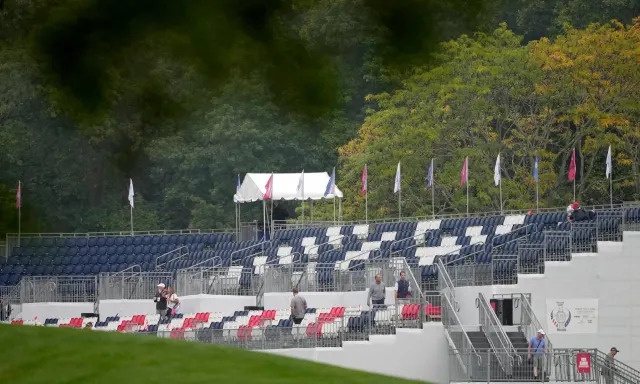Transport chaos mars Solheim Cup start as Nelly Korda steers US to early lead
Organisational chaos marked the opening day of the Solheim Cup, with severe logistical issues causing significant delays for thousands of spectators traveling to the Robert Trent Jones Golf Club in Gainesville, Virginia. Tournament officials were compelled to issue a “deeply apologetic” statement after it became apparent that fans faced extensive wait times for shuttle buses from a remote parking location, leading to a disrupted start to the much-anticipated event.
The challenges began early in the day when the designated parking area, Jiffy Lube Live—a concert venue situated approximately 30 minutes from the golf course—became a bottleneck for shuttle transportation. Buses were scheduled to begin transporting spectators at 5am, two hours before the first tee time. However, the shuttle service experienced significant delays, only commencing well past the intended start time. As a result, lines of attendees stretched for half a mile, and many faced waits of up to three hours or more. Frustration among spectators was palpable, with some opting to return home rather than endure the lengthy wait.
In response to the crisis, the LPGA issued a formal apology, acknowledging the issues and expressing regret to the fans affected by the transportation problems. The statement promised that the LPGA was making substantial changes to the shuttle system to address these problems and indicated that they were seeking ways to make amends to those impacted.
The social media reaction underscored the extent of the discontent. One comment highlighted the financial investment required for attending the event, including airline tickets, hotel stays, and time off work, juxtaposed against the poor shuttle service. The sentiment was echoed by others who demanded compensation from the LPGA, emphasizing the scale of dissatisfaction among the audience.
The logistical debacle was particularly embarrassing for the Solheim Cup, as the event has a history of facing challenges with crowd management. Last year’s tournament at Finca Cortesin in Spain was also plagued by off-course issues, setting a concerning precedent. Despite these setbacks, the Robert Trent Jones Golf Club has a history of hosting significant golf events, including the Presidents Cup and PGA Tour events, which should have provided a solid foundation for handling large crowds.
As the golf action began, the sparse stands were a stark contrast to the usual bustling atmosphere of the Solheim Cup. US captain Stacy Lewis acknowledged the issue, expressing the need to fill the stands to create a more vibrant and supportive environment. Meanwhile, LPGA officials were seen in urgent discussions nearby, highlighting the gravity of the situation.
Despite the off-course troubles, the US team delivered a strong performance in the morning foursomes, taking an early 3-1 lead over Europe. Lewis had inspired her players with motivational speeches from past captains the night before, a strategy that seemed to pay off immediately. Conversely, European captain Suzann Pettersen faced criticism for her decision to leave Leona Maguire out of the morning session, a decision that became a focal point as the US team dominated.
The first match saw Allisen Corpuz and Nelly Korda triumph over Esther Henseleit and Charley Hull with a score of 3&2. Corpuz emphasized the importance of setting a positive tone for the tournament, while Korda acknowledged the low turnout but maintained a hopeful outlook for improvements. Rose Zhang and Lauren Coughlin followed up with a win against Céline Boutier and Albane Valanzuela, further solidifying the US lead. Lilia Vu and Sarah Schmelzel secured another 3&2 victory over Linn Grant and Carlota Ciganda, ensuring a dominant showing by the US team.
Europe’s sole point in the morning session came from Emily Pedersen and Maja Stark, who managed to secure a win against Ally Ewing and Jennifer Kupcho. Despite an early lead of 4 up after five holes, Pedersen and Stark faced a challenge from the US team. Pedersen delivered a crucial iron shot on the 18th hole, leading Europe to their first point of the day.
Pettersen remained composed despite the setbacks, drawing on the experience of the previous Solheim Cup, where Europe made a dramatic recovery after being whitewashed in the first session. Europe’s strategy included turning to Maguire and Georgia Hall for the afternoon fourballs, aiming to close the gap and shift the momentum in their favor.
As the Solheim Cup progressed, both the organisers and participants faced the dual challenge of overcoming logistical hurdles and delivering a high-quality golf competition, with the hope that subsequent days would see improvements in both areas.






